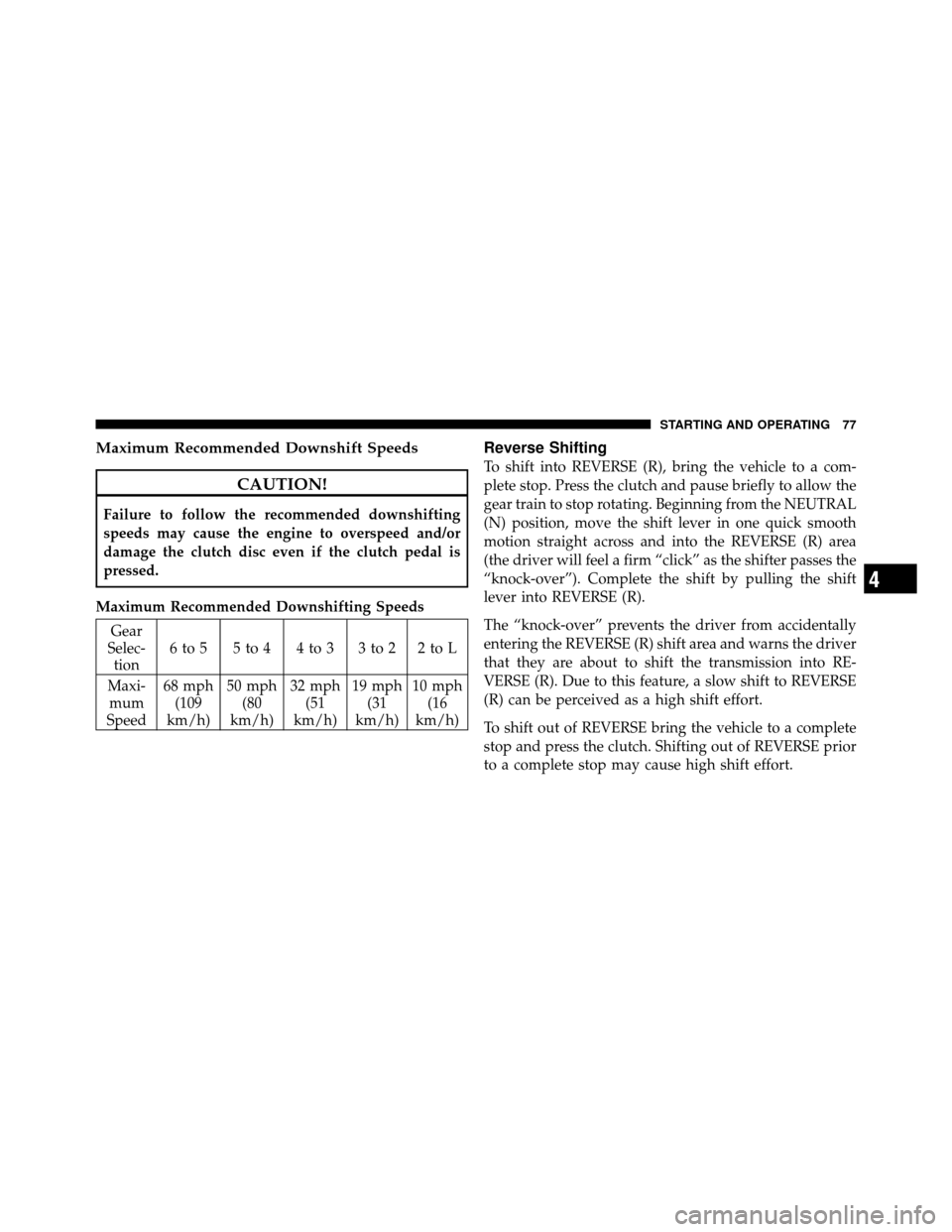Page 61 of 170

AUTOMATIC TRANSMISSION — IF EQUIPPED
CAUTION!
Damage to the transmission may occur if the follow-
ing precautions are not observed:
•Shift into PARK only after the vehicle has come to
a complete stop.
•Shift into or out of REVERSE only after the
vehicle has come to a complete stop and the engine
is at idle speed.
•Do not shift from REVERSE, PARK, or NEUTRAL
into any forward gear when the engine is above
idle speed.
•Before shifting into any gear, make sure your foot
is firmly on the brake pedal.
WARNING!
•Unintended movement of a vehicle could injure
those in and near the vehicle. As with all vehicles,
you should never exit a vehicle while the engine is
running. Before exiting a vehicle, you should
always shift the transmission into PARK, remove
the key fob from the ignition, and apply the
parking brake. Once the key fob is removed from
the ignition, the shift lever is locked in the PARK
position, securing the vehicle against unwanted
movement. Furthermore, you should never leave
unattended children inside a vehicle.(Continued)
60 STARTING AND OPERATING
Page 65 of 170

Gear Ranges
DO NOT race the engine when shifting from PARK or
NEUTRAL position into another gear range.
PARK
This range supplements the parking brake by locking the
transmission. The engine can be started in this range.
Never use PARK while the vehicle is in motion. Apply
the parking brake when leaving the vehicle in this range.
Always apply the parking brake first, then place the shift
lever into the PARK position. On four-wheel drive ve-
hicles be sure that the transfer case is in a drive position.
WARNING!
•Never use the PARK position as a substitute for
the parking brake. Always apply the parking
brake fully when parked to guard against vehicle
movement and possible injury or damage.(Continued)
WARNING! (Continued)
•Your vehicle could move and injure you and others
if it is not completely in PARK. Check by trying to
move the shift lever back and forth without first
pulling it toward you after you have set it in
PARK. Make sure it is in PARK before leaving the
vehicle.
•It is dangerous to move the shift lever out of PARK
or NEUTRAL if the engine speed is higher than
idle speed. If your foot is not firmly on the brake
pedal, the vehicle could accelerate quickly forward
or in reverse. You could lose control of the vehicle
and hit someone or something. Only shift into
gear when the engine is idling normally and when
your foot is firmly on the brake pedal.
REVERSE
This range should be used only after the vehicle has come
to a complete stop.
64 STARTING AND OPERATING
Page 72 of 170

REVERSE
This range should be used only after the vehicle has come
to a complete stop.
NEUTRAL
Use this range when the vehicle is standing for prolonged
periods with the engine running. The engine may be
started in this range. Set the parking brake if you must
leave the vehicle.
DRIVE
This range provides all forward gears, including fourth
gear direct, fifth and sixth. Use this range for most city
and highway driving. Upshifts into both overdrive gears,
fifth and sixth, will be delayed when the transmission
fluid temperature is between -4°F (-20°C) and 41°F (5°C).
During very cold conditions when the transmission fluid
is below -4°F (-20°C), the transmission will be limited to
third gear. Normal operation will return after the trans-
mission fluid warms up.NOTE:
Use caution when operating a heavily loaded
vehicle in second or first gear selections in high ambients
as torque converter slip can impose significant additional
heat load on the cooling system.
Overdrive Operation
The Overdrive automatic transmission contains an elec-
tronically controlled fifth and sixth gear. The transmis-
sion will automatically shift from DRIVE to fifth or sixth
gear if the following conditions are present:
•the shift lever is in DRIVE;
•the engine coolant has reached normal operating tem-
perature;
•vehicle speed is above approximately 38 mph
(61 km/h) for fifth gear and 50 mph (80 km/h) for
sixth gear;
•the “TOW/HAUL” switch has not been activated
(sixth gear is inhibited in “TOW/HAUL” mode);
4
STARTING AND OPERATING 71
Page 78 of 170

Maximum Recommended Downshift Speeds
CAUTION!
Failure to follow the recommended downshifting
speeds may cause the engine to overspeed and/or
damage the clutch disc even if the clutch pedal is
pressed.
Maximum Recommended Downshifting Speeds
Gear
Selec- tion 6to5 5to4 4to3 3to2 2toL
Maxi- mum
Speed 68 mph
(109
km/h) 50 mph
(80
km/h) 32 mph
(51
km/h) 19 mph
(31
km/h) 10 mph
(16
km/h)
Reverse Shifting
To shift into REVERSE (R), bring the vehicle to a com-
plete stop. Press the clutch and pause briefly to allow the
gear train to stop rotating. Beginning from the NEUTRAL
(N) position, move the shift lever in one quick smooth
motion straight across and into the REVERSE (R) area
(the driver will feel a firm “click” as the shifter passes the
“knock-over”). Complete the shift by pulling the shift
lever into REVERSE (R).
The “knock-over” prevents the driver from accidentally
entering the REVERSE (R) shift area and warns the driver
that they are about to shift the transmission into RE-
VERSE (R). Due to this feature, a slow shift to REVERSE
(R) can be perceived as a high shift effort.
To shift out of REVERSE bring the vehicle to a complete
stop and press the clutch. Shifting out of REVERSE prior
to a complete stop may cause high shift effort.
4
STARTING AND OPERATING 77